Georeference Data
The “Georeference ” tool can be used to re-locate spatial data on a Map 2D or Map 3D reference frame.
![]() Tools > Georeference
Tools > Georeference
Concepts
Georeferencing
Aligning geospatial data to a known coordinate system so it can be viewed, queried, and analyzed together with other geo-referenced data.
Georeferencing requires Reference Points and might involve shifting, rotating, scaling, or skewing the data.
Supported transformation methods for Image and Vector Resources:
- Translate: translation
- Translate and Scale: translation + scaling
- Orthogonal: translation + scaling + rotation
- Affine: translation + scaling + rotation + skewing
Supported transformation methods for Point Cloud Resource:
- XYZ translation, XY translation, Z translation
- Generic
- Orthogonal XY
- Orthonormal XY (recommended with precise data)
Point Cloud Resource must be in a Projected Coordinate Reference System (CRS). Geographic and Geocentric CRS are not supported.
Generic Resources and Mapping Resources
Both individual Generic Resources (Vector, Images, Point Cloud) and Mapping Resources can be georeferenced.
To georeference a Mapping Resource, the Mapping Resource must have a Point Cloud Layer. Additionally, the Mapping Resources must be Consolidated to apply the georeferencing to all Mapping Resource Layers.
Map 2D or Map 3D
- Map 2D: Required to georeference Image or Vector Data
- Map 3D: Required to georeference Point Cloud Data and Mapping Resources
Glossary
- Reference Resource
One or more already georeferenced datasets having a known CRS, to be used as a reference for georeferencing a New Resource. - New Resources
One Generic or Mapping Resource with a local origin, but already stored in the expected target CRS. - Mean Fault
Measure the differences between values predicted by a model or an estimator and the values actually observed. In our case, differences between values in the reference dataset and the ones measured in the file are to be georeferenced. - Ground Control points
Locations with known coordinates in the reference data, can be exactly identified in the resources to be georeferenced.
How to Georeference
- Select Reference Point ID from the Sidebar
- Measure the Reference Point on Reference, Map 2D / Map 3D
- Measure the Reference Point on New Resource, Georeference Tab
- Complete Reference Point measurements for at least Reference Points
- Check overall fault.
- Choose the transformation method.
- Process
Georeference Sidebar
Data Type
Select Data Type: Image (Ortho, Raster), Vector, or Point Cloud.
Project
The name of the added data file to georeference will be shown here
- Reset to delete all measured corresponding points
- Close to closing the georeferencing project
Reference Points
Measure corresponding Reference Points on a) Reference Resource on Map 2D / Map 3D and b) New Resource in the Georeference Tab.
- Overall Fault can be calculated when 3 Reference Points are measured.
- Add additional Reference Points to be measured or Remove the selected Reference Point.
- Focus the Map to the selected Reference Point
- Measure Reference to start the measurement of a Reference Point on Map 2D / Map 3D
- Measure New Resource to start the measurement of a Reference Point on the Georeference Tab.
The overall fault is the average offset of measured Reference Points. To improve the georeference result, keep the overall fault as low as possible. The overall mean fault should be lower than 0.2. If higher, review the Reference Points with the largest fault.
Measure Options
The measure options give direct access to the 3D Hover Preferences.
Transformation
Select the mathematical georeferencing method
Process
- Image Resource: Calculate and save georeference information into the worldfile.
- Vector and Point Cloud Resource: Convert data and set CRS in Orbit Resource Description.
Georefence Tab

Open New Resource
The Georeference Tab appears when opening the Georeference Sidebar to open and view the New Resource.
- To load a New Generic Resource, go to the Georeference Tab and open the New Resource.
- To load a New Mapping Resource, go to Resources Catalog > Mapping Resources > Right-Click Context Menu > Georeference.
Toolbar
- Open New Resource
- Navigation Tools to Pan, Zoom, Previous/Next view, Select, see Map View
- Backdrop color to toggle the backdrop fo the Georeference Tab. Useful for displaying white or pale color resources.
Examples
Imagery
Consider the georeferenced context and the image who has to be georeferenced (for example an aerial image)
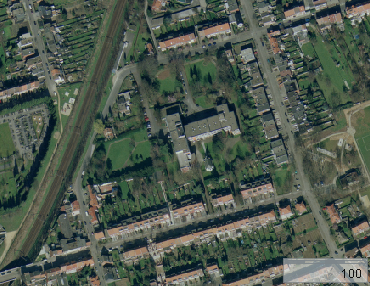
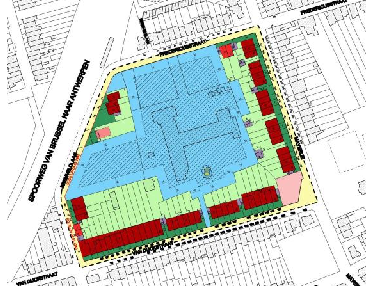
Open the Georeference Calculation Window to determine the control points.
Search a location in one of both views of which you are able to define the exact same location in the other view. Click in the measure-button in the reference column and point out this specific location in the georeferenced context. The same location will be pointed out with the measure-button in the new image column.
Find at least 3 of such locations to be able to georeference the image.

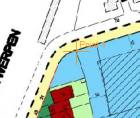
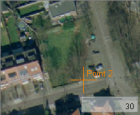
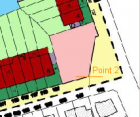
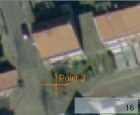
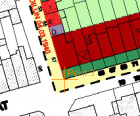
When 2 points are calculated the exact scale can be measured. From the third point on the distortion on this scale is calculated. This is the error visible in the right corner.
The quality of georeferencing will increase if:
- control points are not chosen on one line
- control points are spread over the image
Pointcloud
It is possible to georeference a point cloud using:
- Another point cloud
- A vector file
To use values from .csv,.dbf or .txt files as control points, the user must first import those files as a vector files, and only then start the georeference procedure.
World file
A new text file with the georeference details will be made and saved under the same path as the location of the georeferenced image.
This textfile, which is named a world file contains 6 numbers:
- Line 1: pixel size in the x-direction in map units
- Line 2: rotation about y-axis
- Line 3: rotation about x-axis
- Line 4: pixel size in the y-direction in map units
- Line 5: x-coordinate of the center of the upper left
- Line 6: y-coordinate of the center of the upper left
© Wikipedia
For different resources, the word file will have different extensions :
- resource file - world file
- .omi - .oiw
- .tif - .tfw
- .jpg - .jgw
- .png - .pgw
- .ers - .esw
- .oif - .ofw
- .bmp - .bpw
